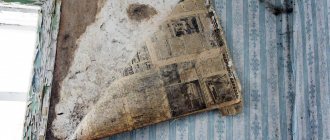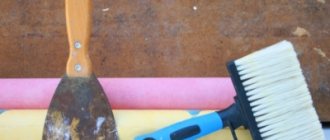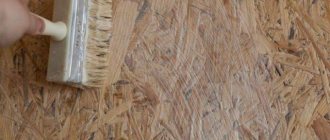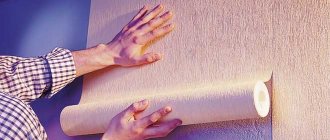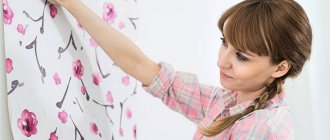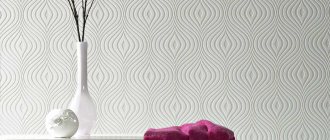Pros and cons of winter gluing
It is no secret that each process has certain advantages and disadvantages, and in our case there are no exceptions either. To understand whether it is possible to glue wallpaper in winter, we suggest studying all the positive and negative aspects.
Let's start with the advantages:
- One of the advantages of this factor is that there are no significant daily temperature fluctuations and drafts in the room, because the windows are tightly closed and the heating system is working. Thanks to this, the likelihood of obtaining a high-quality result from gluing walls increases;
- Some problems are created by an increased level of air humidity, but working heating eliminates this disadvantage to some extent.
Unfortunately, as a drawback, there is unevenness in the drying of the walls - along the radiators, the wallpaper dries faster and better, and the main surfaces reach the desired state later.
Craftsmen advise using PVA glue for gluing - it is less susceptible to differences in temperatures.
Rules for successful pasting
In order for the wallpaper to serve you for a long time and lay flat on the walls, you must follow a number of rules regarding the microclimate in the room:
- The first is the permissible temperature. It should not be lower than +10 °C and higher than +25 °C. It is this temperature range that promotes uniform drying of the wallpaper adhesive base. In addition, this temperature in the house must be maintained not only during the work, but also after it for 10 days.
- The second is air humidity. This figure in an apartment should not exceed 60%. Otherwise, the glue will begin to react with moisture, and its adhesive properties will noticeably decrease, which may cause bubbles to appear and the fabric to peel off.
- Third is the absence of drafts. Even a small draft can have an extremely negative impact on the entire progress of work. The fact is that because of it, the temperature and humidity of the air in the room will constantly change, and this will have a detrimental effect on the adhesive composition and its drying, which can subsequently cause the canvas to peel off.
- Fourth - protection from direct sunlight. If the glued layer of wallpaper is exposed to direct sunlight, this will cause the glue to dry out quickly in some places. As a result, the canvas may wrinkle or sag.
It is quite simple to comply with all these rules in a residential building. You just need to measure the indicators with the usual instruments (thermometer), close all the windows, cover the windows with a cloth and calmly stick on new wallpaper according to the instructions. In this case, the result will please you with quality workmanship for many years.
Which canvases are better to choose?
To better understand whether it is possible to glue wallpaper in a heated room in winter, we suggest considering the existing options and studying the main pros and cons. According to general indicators and performance characteristics, wallpaper material is divided into the following varieties:
- paper - a classic inexpensive option, consisting of one or two layers. It is environmentally friendly, allows water and air flow to pass through, wears out quickly, absorbs various odors and is not subject to wet cleaning;
- non-woven - the structural structure of such a fabric is a paper base on which a material containing fabric fibers is applied. Used for finishing wall surfaces and ceilings, perfectly masks uneven areas, provides vapor permeability, resists wear, is durable and environmentally friendly;
- vinyl - a layer of foamed vinyl is applied to paper or non-woven fabric, providing the wallpaper material with a variety of textures. Wallpaper can be smooth, corrugated, or with a relief pattern. The material has a long service life, practically does not change the original shade when exposed to ultraviolet radiation, masks minor wall defects, and is not susceptible to the negative effects of a humid environment. The positive aspects are the possibility of tenfold dyeing and wet cleaning. Unfortunately, the vapor permeability of the canvas leaves much to be desired;
- acrylic - represented by a layer of foamed acrylic applied to a paper base. Performance characteristics are as similar as possible to vinyl ones. Wallpaper, unlike this analogue, is capable of permeating air, but its service life is somewhat shorter;
- natural - an expensive wallpaper material, the manufacture of which uses bamboo, wood veneer, cork bark, algae and even straw. As a rule, paper is used as a base. It is 100% environmentally friendly, but is susceptible to water and changes color under sunlight;
- glass wallpaper - when creating such canvases, fiberglass is used, which is durable and environmentally friendly. The material is used for a long time and is repainted at least one and a half dozen times. It hides uneven areas of walls under its layer, is non-flammable, and prevents the appearance of mold. The main drawback is the limited number of textures.
- textile - a fabric layer of velor, cotton, linen or silk fibers is applied to a paper or non-woven base. It looks beautiful on the wall, is expensive, protects against extraneous noise and helps conserve thermal energy inside the room. Absorbs odors, gets dirty, gets wet;
- metal – the outer layer is made of thin foil material, characterized by increased wear resistance, resistance to sunlight, and excellent sound insulation. Easily washed off from dirt;
- liquid - a complex structure that combines the quality characteristics of wallpaper material and decorative plaster mortar. The main raw material for preparation is cellulose fibers. It is sold in the form of a dry powder mixture, which is mixed with water immediately before application to the wall. The canvases do not leave joint areas, look beautiful and decorative, perfectly level the wall surface, are environmentally safe and have antiseptic properties. This coating can be used for six to ten years;
- photo wallpaper – base – paper with a self-adhesive surface. The material has a long service life, does not get wet and does not allow air flow to pass through.
What wallpaper is better to glue?
For winter renovations, it is best to use two types of wallpaper:
- Paper-based or completely paper. They allow air to pass through well, which means they will dry evenly. But keep in mind that if you take the thinnest, simplest paper wallpaper, it will be difficult to glue it. More often they wrinkle, tear, and fit together difficult on uneven walls. We'll have to tinker. In addition, such canvases are afraid of water and all kinds of dirt.
- Non-woven. They are made on paper. That is, they stick well to any base. At the same time, non-woven wallpaper has a beautiful dense surface. Sometimes corrugated. And this is especially good for not very smooth walls. Such a surface will hide its imperfections. Non-woven wallpapers are available in various styles, colors, even sizes. Such coatings are not afraid of moderate moisture and are resistant to mild mechanical stress.
Non-woven wallpaper
Interesting: Fashionable wallpaper for the living room 2020
Pasting process
If you decide to glue wallpaper in your apartment in winter, follow all the tips and the sequence of work steps.
Preparatory activities
Having learned that wallpapering is possible in winter, you can easily organize wall repairs before the New Year holidays. First of all, you will have to dismantle the old wallpaper. To facilitate the process of cleaning them, the surface of the decorative material is moistened with warm water, after which it is cleaned with a sharp spatula.
Try to remove old canvas completely, without leaving even small pieces.
Wet wallpaper will increase the level of air humidity, so you will have to wait a while for the room to dry out.
Having removed the old covering layer, the wall surface is inspected for damaged areas. All identified chips, cracks and other defects are repaired using a finishing putty mixture and reinforcing mesh. As soon as the leveling solution has dried, the protruding irregularities are smoothed over with sandpaper.
Padding
It is recommended to use a primer composition containing antiseptic additives. The mixture penetrates deeply into the surface of the wall, holds its small particles together, creates a protective film against the formation of mold, and enhances the adhesion index. The primer is applied in two layers, allowing the time necessary for each of them to dry completely.
If you doubt whether it is possible to glue wallpaper in a cold room, then you are doing the right thing - repair work will not give a positive result.
Pasting wallpaper material
We continue to figure out what time of year is best to hang wallpaper in an apartment and move on to the essence of the main action.
When the surface is completely prepared for work, we begin gluing the canvases. We adjust the design, if necessary, and cut strips of the required length, allowing for a certain margin for trimming.
The sequence of actions is as follows:
- prepare glue, spread it on the canvas or just the wall (depending on the type of wallpaper);
- glue the strip on, press it with a roller or rag, squeezing the air out from under it;
- As soon as the surface is dry, trim off the excess areas along the edges.
Interior decoration of a house in winter: how to achieve high-quality results
Often, the construction of a country house takes more than one year, and construction is divided into successive stages.
First the foundation is poured. Then a “box” with windows, a roof and roofing is installed, and in the third year the finishing is done. It happens that the construction season has ended. Winter is ahead, and interior finishing work, for various reasons, cannot be postponed until spring-summer. What to do? Should you take a risk and start plastering the walls, hanging wallpaper and tiles, regardless of weather conditions? What if everything falls off later? These questions plague novice developers. I built a house with all communications. I’m thinking about doing the interior decoration in the winter so as not to pay for rented housing and move into the cottage in the spring. I want to put porcelain stoneware, tiles and parquet on the floor. Glue wallpaper to the walls, apply decorative plaster or paint somewhere. On the ceiling - plasterboard, lining and also paint. Is it possible to do this if it’s sub-zero outside, or is there a risk that the finish will crack or fall off?
We will answer questions from portal users based on practical experience.
Practical advice
Developers ask the same questions, the answers to which are given below:
- Is it possible to glue wallpaper on a cold wall in winter? This should not be done, since the decorative fabrics will constantly peel off from the surface;
- When is it better to glue wallpaper - in winter or summer? Naturally, the dry summer season is better suited for such repair work. But if you are wondering whether it is possible to glue wallpaper with the heating on, the answer will be yes;
- Is it possible to glue wallpaper in a private house in winter? Quite, because you get the additional advantage that the temperature is regulated by the heating system to which you have access;
- Which wallpapers are best suited for renovation this season? When choosing a material, pay attention to paper wallpaper, vinyl coverings, glass wallpaper and canvases for subsequent painting.
To finally understand whether it is possible to glue wallpaper in an apartment in winter, here are some more useful tips.
The presence of drafts must be completely eliminated. Until the glue dries (and this period lasts from one to two days), it is forbidden to open windows for artificial ventilation of rooms. In addition, it is not recommended to speed up the drying process with household appliances.
To work with wallpaper material, it is better to choose a time when constant temperatures have established, or use the beginning of the heating season for this.
Before carrying out work, make sure the walls are completely dry. To do this, secure a piece of plastic film with tape so that there is free space filled with air inside. After a day, inspect the polyethylene for any drops of moisture underneath. If available, arrange for drying of the surface using heating devices.
Surface primer
In order for wallpaper pasted in winter to last long and reliably, the surface of the walls must be treated with a primer before pasting. As a primer, use the same glue that the wallpaper will be glued to, but only more diluted. Thanks to the primer, a thin film is formed on the wall. Subsequently, the wallpaper glue will no longer be absorbed into the wall, but will hold the wallpaper panel.
If you are forced to wallpaper your walls in winter, you will most likely have to prime the wall surface not once, but several times. This should be done if the wall is quite porous and absorbs the adhesive instantly. This option is typical for new buildings. So, the walls should be primed until a thin film of glue is created on their surface. It can be easily seen with the naked eye.
We solve problems during gluing
When carrying out repairs in winter, you need to know exactly how to re-glue the peeling sheets back on. The problem is that if this is done incorrectly, then in the future this problem will overtake you again and again, precisely in these problem areas. Follow these rules:
- First, the peeled areas of the canvas must be moistened with a damp cloth. It is important to ensure that they are not completely saturated with water.
- Then apply a thin layer of glue to these parts and the surfaces of the walls and leave them for thirty minutes to soak.
- After this, you can re-apply glue to the canvases, wait another 10 minutes, stick them to the wall, smoothing them at the same time with your hand or a steam roller.
- At the last stage, remove any remaining glue with a damp cloth.
Important! If after renovation you still have building materials, pieces or rolls of wallpaper, then you should not store them on the balcony in winter, because you will need them in the future. These products do not like moisture and become deformed when exposed to sunlight. It is better to store them in a dark, dry place, such as a pantry.
What to avoid in summer
The main enemy is dry air and drafts.
At low humidity, humidifiers are not needed; it is enough to apply glue liberally to the walls and saturate the strips well with it. You can’t open the windows even if it’s stuffy and high humidity in the apartment.
The wallpaper takes 24 hours to dry, but it is not recommended to open all windows and doors at once. It is enough to open the door or window for ventilation without creating a draft. In such conditions, the wallpaper should dry for at least 2-3 more days.
It is prohibited to speed up the drying of canvases with a fan, air conditioner or humidifier.
Source
To properly hang wallpaper, you need high-quality finishing materials. But the main criterion for success is temperature.





